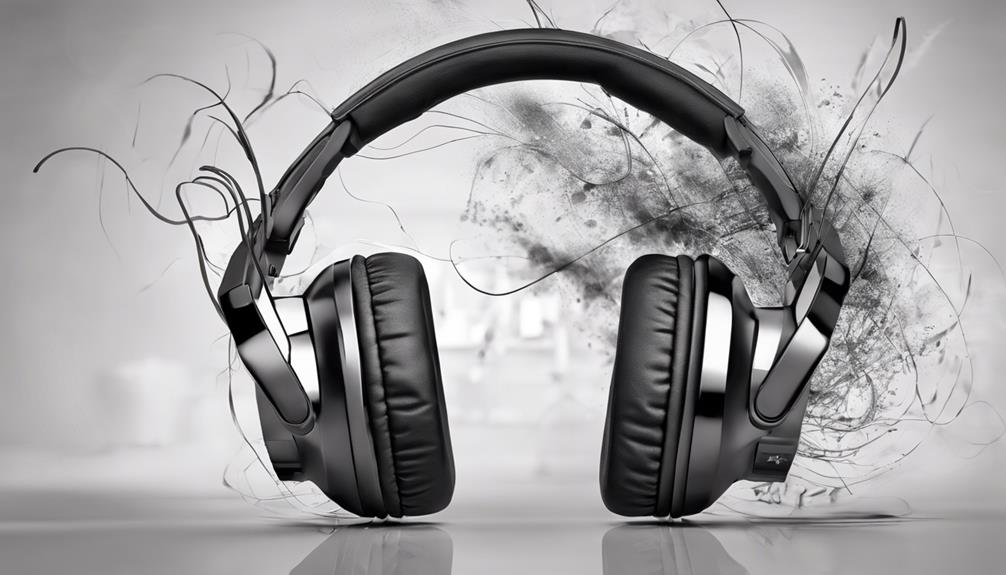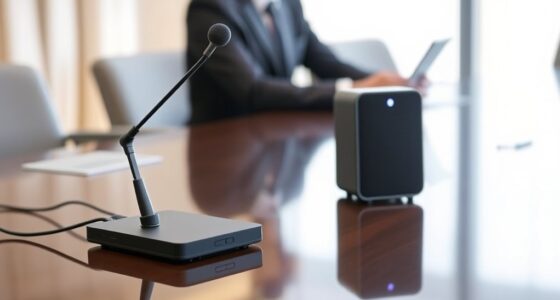Exploring assistive listening devices (ALDs) to enhance listening experiences, we explore advanced technologies designed to accommodate various auditory needs.
From FM systems to hearing loops and infrared systems, each device offers unique benefits in different environments.
But what sets them apart in terms of effectiveness and user experience? Let's delve deeper into the intricacies of these devices and discover how they can significantly improve auditory perceptions for individuals with hearing loss.
Key Takeaways
- ALDs like induction loops and FM systems enhance listening by amplifying sound for clearer reception.
- T-Coils and loop systems provide customized sound adjustments, improving speech clarity for individuals with hearing loss.
- Alerting devices using visual, tactile, or auditory signals help individuals with hearing impairments stay connected and safe.
- Research shows ALDs significantly enhance speech understanding, reduce listening effort, and increase social participation for users.
Types of Assistive Listening Devices
Among the various types of assistive listening devices available, induction loop systems, FM systems, and infrared systems are commonly utilized to enhance listening experiences for individuals with hearing impairments.
Induction loop systems, also known as hearing loops, create a magnetic field that's picked up by T-coils in hearing aids or cochlear implants, allowing users to hear sound directly.
FM systems consist of a transmitter microphone and receiver that can be worn by the user, providing clear sound over distance and reducing background noise.
Infrared systems transmit audio signals using infrared light to headphones or receivers worn by individuals, ensuring privacy and preventing signal leakage.
Additionally, personal amplifiers and amplified phones help individuals with hearing loss by boosting sound levels and reducing interference.
Loop systems and sound field systems are beneficial in classrooms and public spaces, transmitting sound directly to hearing devices or strategically placing speakers for optimal listening.
Alerting devices, utilizing visual or tactile signals, provide notifications to individuals with hearing impairments, enhancing safety and awareness.
Benefits of Using ALDs

ALDs play a crucial role in enhancing sound transmission and speech clarity for individuals with hearing loss, ultimately improving their ability to engage in conversations, perceive environmental cues, and respond to warning signals effectively. By utilizing ALDs, people with hearing impairments can benefit in various ways:
- Improved Hearing: ALDs help individuals hear sounds that they may otherwise miss, such as softer speech tones or distant noises.
- Enhanced Listening Experience: These devices amplify sound, making it easier for users to distinguish speech from background noise, enhancing their overall listening experience.
- Increased Safety: ALDs enable individuals to better detect warning signals in their environment, enhancing their safety and awareness of potential hazards.
The use of ALDs not only assists in overcoming the challenges associated with hearing loss but also contributes to a more fulfilling and engaging life for individuals relying on these assistive devices.
Understanding T-Coils and Loop Systems
Understanding T-Coils and Loop Systems involves delving into the intricate mechanisms that allow for enhanced sound clarity in assistive listening devices for individuals with hearing loss. T-coils, also known as telecoils, are essential components in hearing aids and cochlear implants that detect electromagnetic signals, improving sound transmission. Loop systems, on the other hand, utilize copper wire loops installed around a room to create an electromagnetic field. This field connects with the telecoils in hearing aids, enabling wireless reception and enhancing sound clarity for users. These systems provide cost-effective solutions for individuals seeking personalized sound adjustments based on their specific hearing needs. Additionally, properly installed loop systems require minimal maintenance, making them an efficient long-term investment for those with hearing loss.
| T-Coils | Loop Systems | Telecoils |
|---|---|---|
| Miniature receivers in hearing aids | Use copper wire loops to create electromagnetic fields | Enable wireless reception in hearing loop systems |
| Detect electromagnetic signals for sound clarity | Connect to telecoils in hearing aids for improved sound transmission | Found in hearing aids and cochlear implants |
| Found in hearing aids and cochlear implants | Cost-effective solutions for customized sound | Enhance sound clarity for individuals with hearing loss |
How Alerting Devices Enhance Listening

Alerting devices play a crucial role in enhancing the auditory experience for individuals with hearing impairments by utilizing visual signals, vibrotactile indicators, or alternative auditory cues to signal important events. These devices are essential for alerting individuals to fire alarms, carbon monoxide detectors, doorbells, and baby monitors. They help individuals with hearing loss stay safe and connected by providing necessary alerts in different scenarios.
Visual signals: Alerting devices often incorporate bright flashing lights or LED displays to attract the attention of individuals with hearing impairments.
Vibrotactile indicators: Some alerting devices use vibrations or tactile feedback to alert individuals, such as vibrating wristbands or bed shakers.
Alternative auditory signals: In addition to visual and tactile cues, alerting devices may offer alternative auditory signals like loud alarms or distinctive tones to convey important information effectively.
Latest Research on ALDs
Recent advances in research on assistive listening devices have revealed significant improvements in speech understanding and listening outcomes for individuals with hearing impairments, particularly in challenging, noisy environments. Recent studies show that ALDs can improve speech understanding by up to 50% in noisy situations, reducing listening effort and increasing comprehension for users. These advancements have also been linked to enhanced communication satisfaction and greater participation in social activities among individuals utilizing ALDs. Incorporating wireless technologies into ALDs has been a key focus of recent research, aiming to provide seamless connectivity and improve the overall user experience. Furthermore, clinical trials have demonstrated that ALDs not only contribute to better academic performance but also foster increased classroom engagement for students facing hearing difficulties. The table below summarizes key findings from recent research on ALDs:
| Research Findings | Impact |
|---|---|
| Improved speech understanding in noisy environments | Up to 50% enhancement |
| Reduced listening effort and increased comprehension | Enhanced listening experience |
| Enhanced communication satisfaction and social participation | Improved quality of life |
Frequently Asked Questions
What Are Examples of Assistive Listening Devices?
Examples of assistive listening devices encompass:
- FM systems, which incorporate a portable microphone for the speaker and a receiver for the listener.
- Infrared systems, which utilize light waves to transmit sound wirelessly to receivers.
- Hearing loop systems, which employ electromagnetic energy to transmit sound directly to hearing aids.
- Personal amplifiers, which enhance sound clarity by reducing background noise and amplifying the speaker's voice.
- Sound field systems, which amplify sound evenly throughout a room to benefit all listeners.
What Device Do They Use to Help Better Someone's Hearing?
We harness telecoils in hearing aids and cochlear implants to connect wirelessly to hearing loop systems for enhanced sound reception.
These telecoils adeptly convert electromagnetic signals into clearer sound, reducing background noise and enriching listening experiences.
The magnetic fields generated by hearing loop systems are picked up by the telecoils in our hearing devices, enabling direct sound transmission.
This technology is pivotal for tailoring sound to individual preferences and optimizing access to assistive listening systems.
What Is the Most Commonly Used Type of Assistive Listening System in Educational Settings?
In educational settings, the most commonly used assistive listening system is the FM system.
It consists of a portable microphone for the speaker and a receiver for the listener.
FM systems are effective in minimizing background noise, distance issues, and acoustical effects in classrooms.
What Are the Benefits of Assisted Listening Devices?
Assisted listening devices offer significant benefits. They enhance speech understanding by up to 15-25 dB for individuals with hearing loss. These devices improve communication, social interaction, and educational engagement.
They can also reduce feelings of anxiety, depression, and isolation associated with hearing difficulties. Research indicates that assisted listening devices can provide speech understanding levels comparable to those with normal hearing.
Their impact on overall quality of life is profound.
Conclusion
Just as a lighthouse guides ships safely to shore through turbulent waters, assistive listening devices illuminate the path to clearer communication for individuals with hearing loss.
These devices, from FM systems to hearing loops, provide a beacon of hope in navigating the challenges of hearing impairment.
With the power of technology and research, we can continue to improve listening experiences and help individuals connect more effectively with the world around them.











